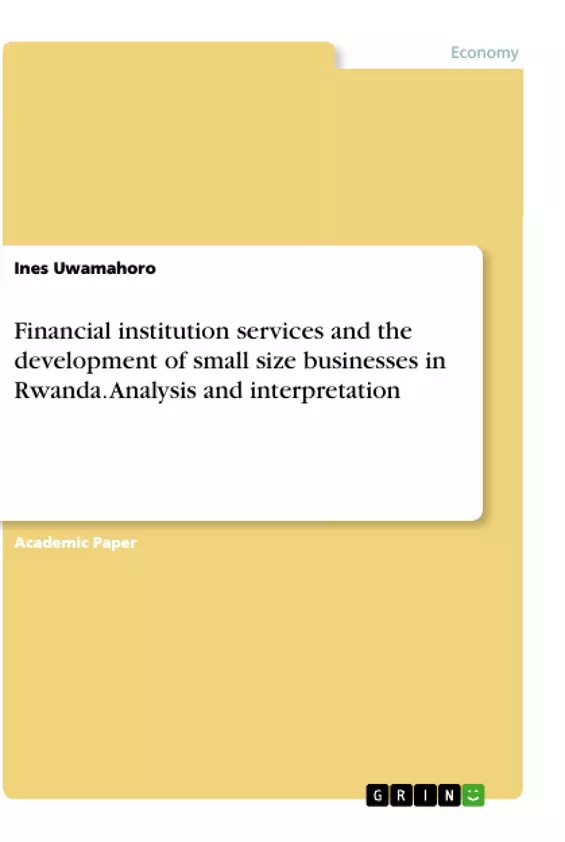The main purpose of this study was to investigate the role of financial institution services on the development of small size businesses in Rwanda. This design of study was a descriptive and correlation research. The population of this research was 31 managers of small businesses financed by Unguka bank in Bigogwe sector. The questionnaires were used to collect primary data and various books, journals, and internet for secondary data. In this research, financial institution services is an independent variable while development of small size businesses in Rwanda is a dependent variable.
The data collected from respondents were analyzed using SPSS version 22 and the result from analysis, interpretation, and presentation of data was displayed in the tables. The correlation method was used to find out if there is a relationship between financial institution services and development of small size businesses in Rwanda.
Inhaltsverzeichnis (Table of Contents)
- ABSTRACT
- DEDICATION
- TABLE OF CONTENTS
- LIST OF ABBREVIATION AND ACCRONYMS
- ACKNOWLEDGEMENT
- CHAPTER 1
- INTRODUCTION
- Background of the Study
- Statement of the Problem
- Research Questions of the Study
- Objectives of the Study
- Hypothesis of the Study
- Significance of the Study
- Justification of the Study
- Theoretical and conceptual framework
- Scope of the Study
- Definition of Key Terms
- CHAPTER 2
- REVIEW OF LITERATURE AND RELATED STUDIES
- Financial Institution Services
- Saving services
- Loan Provision
- Financial Guidance
- Development of Small Size Business
- Challenges Facing Small Size Business Development in Rwanda
- Increase of Customers
- Increase of Revenues
- Productivity Improvement
- CHAPTER 3
- RESEARCH METHODOLOGY
- Research Design
- Population and sampling techniques
- Sampling techniques
- Research Instrument
- Data gathering procedures
- Statistical Treatment of Data
- Correlation
- Ethical Consideration
- CHAPTER 4
- PRESENTATION OF FINDINGS, ANALYSIS AND INTERPRETATION
- Demographic Information
- Perception of Respondents on financial institution services
- Perception of Respondents on development of small size businesses in Rwanda
- Analysis of correlation and Hypothesis Testing
- CHAPTER 5
- SUMMARY, CONCLUSION AND RECOMMENDATIONS
- Summary
- Conclusion
- Recommendations
- REFERENCES
- LIST OF TABLES
Zielsetzung und Themenschwerpunkte (Objectives and Key Themes)
This study aims to examine the impact of financial institution services on the development of small-scale businesses in Rwanda. The research focuses on the relationship between financial institution services and the growth of these enterprises.
- The role of financial institution services in supporting small-scale business development in Rwanda.
- The impact of financial institution services on key metrics like customer growth, revenue increase, and productivity enhancement.
- The challenges faced by small-scale businesses in Rwanda in accessing and utilizing financial institution services.
- The relationship between financial institution services and the overall growth and success of small-scale businesses.
- The importance of affordable interest rates and other financial support mechanisms for fostering small-scale business development.
Zusammenfassung der Kapitel (Chapter Summaries)
Chapter 1 introduces the study's background, outlining the problem of small-scale business development in Rwanda and the role of financial institutions. It defines the research questions, objectives, and hypothesis, outlining the study's scope and key terms. Chapter 2 provides a comprehensive review of existing literature and related studies, exploring the concepts of financial institution services, saving services, loan provision, financial guidance, and the development of small-scale businesses, while highlighting challenges faced by small-scale businesses in Rwanda. Chapter 3 delves into the research methodology employed, describing the research design, population, sampling techniques, data gathering procedures, statistical treatment of data, and ethical considerations. Chapter 4 presents the findings, analysis, and interpretation of the collected data, focusing on demographic information, respondent perceptions of financial institution services and small-scale business development, and the analysis of correlation and hypothesis testing.
Schlüsselwörter (Keywords)
The primary keywords and focus topics of this study include financial institution services, small-scale business development, Rwanda, economic growth, loan provision, saving services, financial guidance, interest rates, challenges, and empirical research.
- Citation du texte
- Ines Uwamahoro (Auteur), 2021, Financial institution services and the development of small size businesses in Rwanda. Analysis and interpretation, Munich, GRIN Verlag, https://www.grin.com/document/1031032



